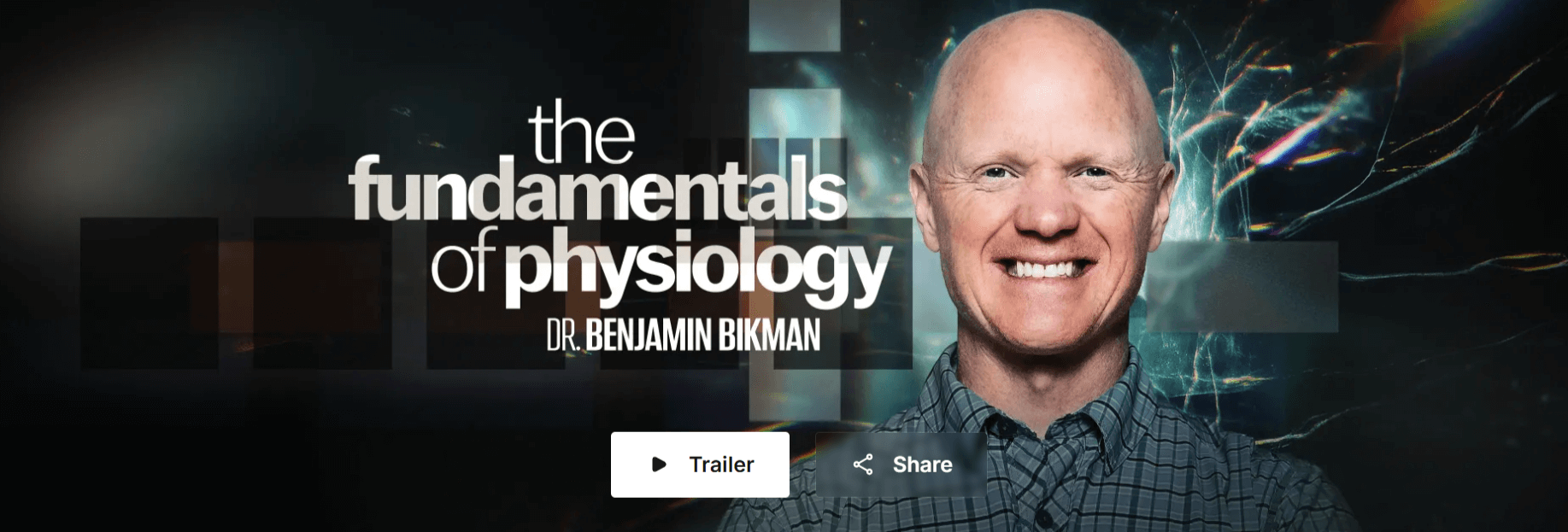🌟 New Year Offer 🌟
Celebrate 2025 with 30% OFF on all products! Use code: NEWYEAR2025. Hurry, offer ends soon!
A comprehensive exploration of human physiology, beginning with cellular fundamentals and progressing through major body systems.
File Size: 7.475 GB.
Format File: 7 MP4, 7 SRT, 8 TXT.
Peterson Academy – Benjamin Bikman – The Fundamentals of Physiology

Dr. Benjamin Bikman
Biologist
In The Fundamentals of Physiology, a seven-hour course, Dr. Benjamin Bikman provides a comprehensive exploration of human physiology, beginning with cellular fundamentals and progressing through major body systems. We examine the complex mechanisms that maintain homeostasis, delve into the intricate relationships between various organ systems, and discuss clinically relevant topics and modern applications. The course offers a thorough understanding of how the human body functions and the crucial role of each system in maintaining overall health.
Lectures
1. Cells in Balance
In our introductory lecture, Dr. Benjamin Bikman presents the fundamentals of cell physiology, focusing on three key areas: homeostasis, membrane transport, and electrophysiology. The lecture explores how cells maintain balance through negative and positive feedback systems, examines the mechanisms of passive and active transport across cell membranes, and details how electrical signals are generated and propagated through neurons. The session establishes foundational concepts essential for understanding broader human physiological systems that are covered in subsequent lectures.
3. Skeletal Muscle Physiology
In lecture three, we study the complex structure and function of skeletal muscle, examining its organization from the macro level down to the molecular components involved in muscle contraction. Dr. Bikman delves into the cross-bridge cycle, the process by which myosin and actin filaments interact to generate force, and the crucial role of ATP in this process. The lecture concludes by discussing different muscle fiber types and the mechanisms of muscle fatigue, dispelling common misconceptions about lactic acid’s role in muscle soreness.
4. Cardiopulmonary Physiology
In lecture four, we learn about the cardiopulmonary system, examining the intricate relationship between the heart and lungs in maintaining circulation and gas exchange. The lecture details the heart’s four-chamber structure, blood flow patterns, and electrical conduction system, before transitioning to lung physiology, including the mechanics of breathing, gas exchange, and the role of surfactant. We also cover the oxygen-hemoglobin dissociation curve, highlighting the complex interplay between the cardiovascular and respiratory systems in maintaining homeostasis. Finally, we discuss clinically relevant topics within these two systems.
5. Gastrointestinal Physiology
In lecture five, we investigate the gastrointestinal system anatomy and physiology, including the essential roles of accessory organs like the liver and pancreas in digestion and absorption. The lecture examines four key processes throughout the GI tract—motility, secretion, digestion, and absorption—while detailing how different nutrients are broken down and absorbed. The discussion concludes with an examination of gut hormones, particularly GLP-1, and their modern applications in weight loss medications.
6. Endocrine Physiology
In lecture six, we look at the endocrine system’s complex network of hormone signaling, beginning with fundamental concepts of hormone classification and their transport mechanisms through the bloodstream. We examine the hypothalamic-pituitary axis and its regulation of key hormones including growth hormone, thyroid hormone, and adrenal hormones, discussing various disorders associated with their dysfunction. The lecture concludes with a detailed analysis of pancreatic function, insulin resistance, and subsequently, type 2 diabetes.
7. Adipose Physiology
In our seventh and final lecture, we explore the adipose system, examining the development, types, and functions of fat tissue in the human body. The discussion covers the distinction between white and brown adipose tissue, their unique metabolic roles, and the mechanisms of fat storage through hyperplasia and hypertrophy. Dr. Bikman concludes the lecture by emphasizing insulin’s crucial role in fat storage and the concept of personal fat threshold, highlighting their role in determining metabolic health.
Course Features
- Lectures 0
- Quizzes 0
- Duration 10 weeks
- Skill level All levels
- Language English
- Students 78
- Assessments Yes












